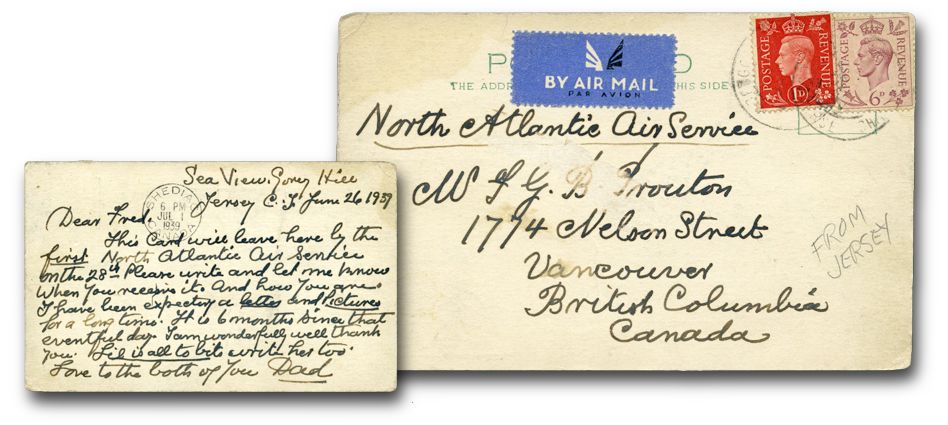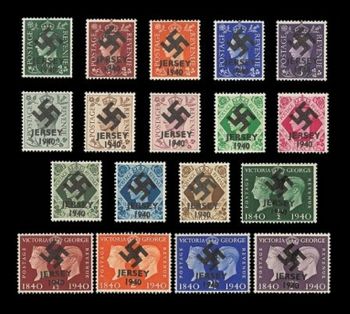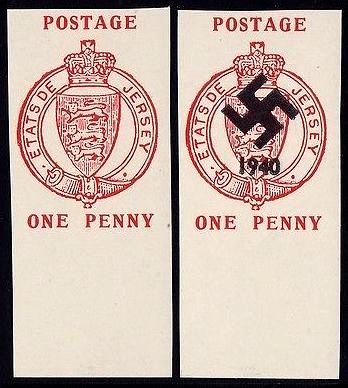The Channel Islands at war — Islanders had always used British stamps
Despite their relative isolation and strong desire for independence, Channel Islanders had long kept in touch with each other and with the outside world through the auspices of the British General Post office. Unlike British colonies, which issued their own stamps, the islanders had used British stamps since 1840, when the world’s first adhesive postage stamp, the Penny Black was issued.
At the time of the occupation, two different sets of stamps were in common use, including definitive stamps picturing King George VI, the reigning monarch, and a set of stamps commemorating the Postage Stamp Centenary issue of 1940. Some post offices and individuals apparently had small quantities of the earlier George V definitives and other stamps.


Used envelopes (called “covers” by philatelists)1 and postcards bearing British stamps and posted from Jersey and Guernsey are common; the postcard shown below, franked with two British stamps, was posted from Jersey in 1939.

Business almost as usual at the post office…
With the arrival of the German occupation force, communication by mail with the outside world ended for the Channel Islanders who had not been evacuated (limited communication with relatives and friends abroad would eventually available through the International Red Cross Message Scheme). Local mail services within the Channel Islands continued, however, and temporarily, at least, British stamps would continue to be used.
The Nazis make a postal blunder
Within weeks of the occupation, German officials proposed to overprint contemporary British stamps in an attempt to further “Germanize” the Channel Islands. It is not known why overprints on German stamps weren’t considered, as they were in other occupied territories.

In Guernsey, essays2 utilizing the 1d King George VI definitive and the 2d Postage Stamp Centenary stamp were produced; according to the Stanley-Gibbons stamp catalogue, the German commandant on Guernsey had stamps overprinted with two swastikas and submitted them to Berlin, but the Government vetoed them, reputedly so as not to antagonise the local population.
On Jersey, where the overprint included “Jersey 1940,” the essays covered all current King George VI definitives and the Postage Stamp Centenary set, in both cases excluding the 1d values, which had sold out. When the Jersey bailiff protested to Berlin, the commandant was told not to distribute them.
The only occupation overprints to survive are one or two sets of the Jersey stamps, held in private collections. Any Jersey or Channel Islands occupation overprints for sale today are reproductions or forgeries.
Even if the authorities in Berlin had approved the project, it would have soon failed: The moment the German occupation began, postmasters could no longer order supplies of stamps from Great Britain. Soon, stocks would begin to dwindle and a small postal crisis would ensue. But before that happened…
États de Jersey essays fail to make the grade

The Germans made yet another attempt to solve the coming shortage of British postage stamps. États de Jersey (State of Jersey) postal essays for an imperforate one-pence Jersey stamp were commissioned by the Germans and produced by Bigwoods, a Jersey firm. Some of the essays were overprinted with swastikas. Due to objections from the Bailiff of Jersey, and following consultations with Berlin, they, like the proposed overprints on British stamps, were also rejected and never placed in use. Only two sheets of 30 of each stamp have been recorded; many individual stamps were damaged, and only a tiny number of perfect examples exist.
A specialist collector of Channel Islands stamps, Chris Forwood, noted in a 2017 email that the essays illustrating this web page are fakes. He wrote, “…the originals were printed in letter press, hence you don't get the smudged lines. Also, there should be a frame break on the outside frame at the 8 o'clock position by the ‘T’….” He noted that the overprint is the wrong size.
Next, in Part 3: In an attempt to stretch supplies of British stamps, German authorities allow the bisecting of 2d definitive stamps to create two 1d stamps; in the new year of 1941, postal workers in Guernsey have to modify a cancellation device because replacement parts can't be imported from Great Britain; military authorities order civil authorities to issue stamps for both Jersey and Guernsey.
-
Philatelists refer to used envelopes as covers, a term from the time before the first modern envelopes were manufactured in 1845. Previously, letters were protected by separate sheets of paper which were folded over the letters to cover them. However, because postage rates were based on the number of sheets of paper being mailed, people saved money by writing a letter on one side of a sheet of paper, then folding it in such a way that the blank side faced outward and provided space for the address, stamps (after the invention of the postage stamp in 1840), and postal markings. ↩︎
-
An essay is a design for a proposed stamp submitted to postal authorities for consideration. ↩︎